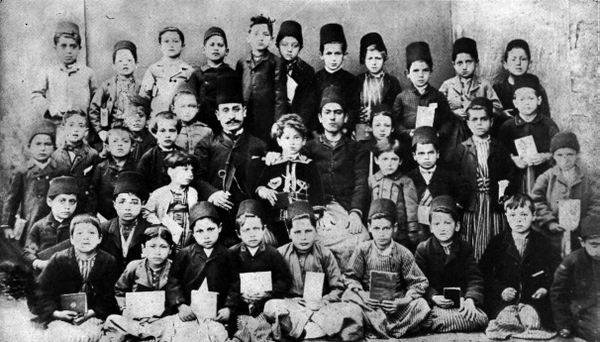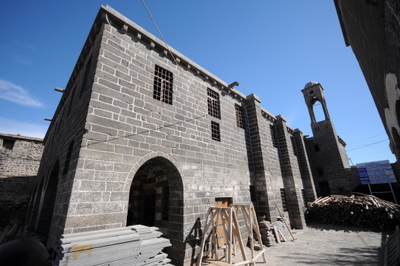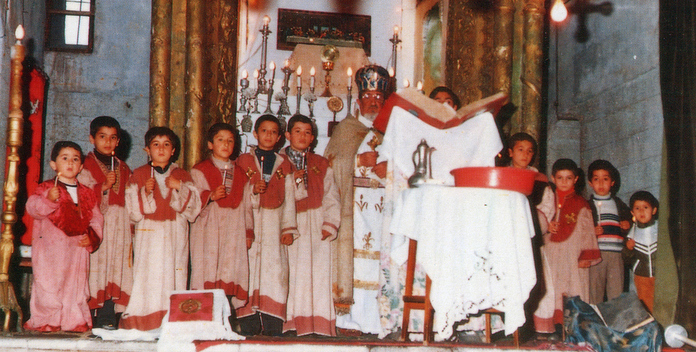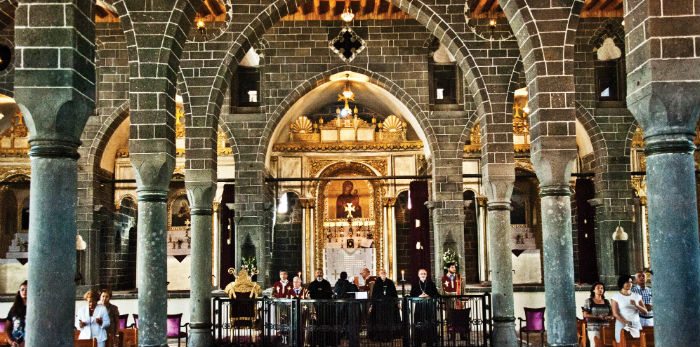The debates that started after the urgent expropriation decision, which involves the churches in Diyarbakir, made the history of Sur, Suriçi a current issue. Having an important role in the history of Anatolian Armenians and Christians, Diyarbakir, and especially Suriçi, have been at the center of such practices throughout its history. Zakarya Mildanoğlu tells about the story of Suriçi churches and the expropriation history of Diyarbakir.
My late mother used to say, “An ember burns where it falls.” An ember has no religion, language or color. Now, the embers fell on Diyarbakir, on the places where Kurdish population live in the southeast of Turkey. The reason is the “ditches” that couldn't have been filled for centuries. According to the majority of experts, these embers won't fill those ditches either. Once upon a time, almost the half of the population of Diyarbakir was consisting of Armenians. Today, there is almost no Armenians in Diyarbakir. However, after 100 years, Armenians who converted voluntarily or involuntarily to Islam started to come together in the yard of Surp Giragos Armenian Church on every Sunday. However, the embers fell on the neighborhood of “infidels” once again.
During Ottoman times, there were 148 churches and 10 monasteries belonging to Armenians within Diyarbakir. 11 of those churches was within the borders of today's Diyarbakir, which was a province back then. Some of the glorious Armenian places of worship turned into mosques or military barracks. Surp Toros Church was the most famous one; it was turned into a mosque in 1518 and became to be known as Kurşunlu Mosque. After this church was confiscated, Surp Giragos Church was built in the graveyard of that church in the late 16th century and Armenian Archiepiscopate of the region was moved there. Surp Giragos Church was burned to ashes in 1881. This fire became a subject to the legends all over Anatolia at that time.
In 1883, the church was rebuilt with the supports of the notable Armenians in the region. However, this wasn't the last disaster that befell Surp Giragos. In 1913, its bell tower was destroyed by a lightning. About 2 years later, a monumental new tower was built. However, just in the eve of 1915 Armenian Genocide, the bell tower was demolished by cannonballs, since it was taller than all the minarets around. Damaged in 1915, the church was used as quarters by German commanders during WW I. Then, it was served as a cotton storage for Sümerbank. Having opened to worship in 1960, the church became deserted, since Armenians started to migrate to the western cities or Europe because of the security concerns. Meanwhile, Surp Giragos turned into a ruin. However, Diyarbakir Armenians in Istanbul and all around the world opened the church to worship in 2011. We will see the damage that was done to Sur, where Surp Giragos is located, when people will be allowed to enter the province.
Surp Sarkis Church
Surp Sarkis was the second Armenian church in "the neighborhood of infidels" in Diyarbakir. In 1903, Surp Giragos had a school with 480 male and 274 female students and 20 teachers. And Surp Sarkis' school had 80 male and 50 female students and 5 teachers. These two schools had a competition, sometimes friendly and sometimes fierce, going on depending on the competition among Armenian political parties. The number of female students is remarkable. In 1892, there was another school belonging to Nacary, who serves as the secretary to the spiritual leadership. In Diyarbakir, there were also Protestant and Catholic Armenian schools. Some of the Armenians were going to those schools.
At the center of Diyarbakir, there were Surp Giragos Church (at the center), Surp Sarkis Church (at the center), Virgin Mary Monastery (in Alipınar), Surp Taniyel Church (in Bahçecik), Virgin Mary Church (Çirnik/Pınardüzü), Surp Simon Church (in Karabaş), Armenian Church (in Karakilise/Dökmetaş), Surp Krisdofor Church (in Kabi/Bağıvar), Surp Agop Church (in Keterbi), Surp Tukhmanug Church (in Satıköy) and Surp Yeğya Church (in Zemieğik/Elidolu). Majority of these churches are used for different purposes by public institutions. A part of Süleyman Nazif Elementary School, where many Armenians were educated, belongs to one of these churches. In Diyarbakir, churches of different communions and ethnic groups were standing next to each other. For instance, Surp Giragos and Mar Patyun Chaldean Church was on the same street.

Education campaign
In 1847, Istanbul-based Antsnıver Hayuyats Ingerutyun (Altruistic Armenian Women Foundation) established a branch in Diyarbakir. Their purpose was to teach the children, especially to girls, how to write and read on Sundays. In addition to this foundation, there were two more foundations, "Hayrenasirats" and "Mesropyan", which had the purpose of teaching the craftsmen how to write and read. The former was founded by Tovmas Zarzavatçıyan, who returned from Jerusalem in 1865 and wanted to use his education and knowledge for improvement of his people. Zarzavatçıyan, through “Hayrenasirats”, founded a school within Surp Sarkis and began to teach Armenian with new methods. Board members of “Hayrenasirats” were sending their children to that school, which was an half-an-hour-walk away from their houses in Surp Sarkis neighborhood. Young children were going to the school on Sundays, even when the weather conditions were adverse. After a while, Zarzavatçıyan started to offer Sunday classes for adults. He encouraged the adults to produce with new methods in different business sectors. With this initiative, the will to have a profession instead of begging on the streets and development became the common purpose of the society. Many craftsmen improved in their professions.
In Diyarbakir, a local newspaper called “Diyarbakir” was published. It was in Turkish with Armenian letters and for a while, it was published in 3 languages: Armenian, Turkish and Arabic. Containing official notices, laws and ads, this newspaper published 1000 Turkish, 500 Armenian copies in a week.

The history of expropriation
The recent controversial expropriation was decided by the cabinet and it is based on Article 27 of Expropriation Law, that was enacted in 1983. Though the governorship stated that this doesn't mean that all the private properties in the region will be expropriated, all the churches in Sur are in the scope of the expropriation. Moreover, shops and residences in Sur belonging to Surp Giragos Church are also expropriated.
Putting the technical details of the Expropriation Law aside, let's look at Article 27 which sheds a light to the expropriation in Sur:
“In cases of expropriation subject to a Cabinet Decree for national defense of an emergency as per the provisions of the 'Law of National Defense Obligations' No. 3634 or for the expropriation of immovable property in emergencies as stipulated in special laws, any immovable property may be seized by the related administration.”
This article raises this question: “What is the 'Law of National Defense Obligations'?” The related articles of this law, which was enacted in 1939, are as the following:
Article 1: In the state of war or mobilization, or during the tensions and crises when there is a possibility to declare war, every citizen is obliged to provide all the military needs and services that cannot be obtained by ordinary means.
Article 2: The cabinet will declare the time when these obligations will be performed in the entire land or some regions in Turkey.
These article indicates a bleak situation. The state acknowledges that what is happening in Suriçi is a war. The term “state of war” doesn't have a pleasant echo in Armenians' mind. Unavoidably, I think about what happened a century ago. Before 1915 Armenian Genocide, the friendly atmosphere in the streets of Diyarbakir was suddenly destroyed by the butchers of the Unionists. One morning, Armenian traders, physicians, lawyers, engineers, shopkeepers, civil servants, judges and priests in Diyarbakir were imprisoned. The raids that started under the guise of searching for weapons turned into a massacre. Young Armenian people who were recruited were killed. Rest of the Armenians, which constituted the half of the city population, began their journey to the desert. And the economy of Diyarbakir started to decline. After the Armenians who were engaged in jewelry, stone-masonry and copper, cotton, silk, grain and wool trading were gone, Syriacs, Chaldeans, Catholic and Protestant Armenians, Yazidis, Greeks and few Jews were also gone and thus, Diyarbakir lost its colors.

Urban transformation
When I was an architecture student in Istanbul Technical University, Varto was used as an example in our earthquakes and new settlements class. After the earthquake, new residences were built for locals of Varto, but they started to live in caves, since they thought that new residences don't fulfill their needs and the caves are more convenient for them. In many places in Anatolia, there are residences in ruins which were planned as earthquake residences. People still remember that the public building are the first ones to fall down in an earthquake. In Sulukule, where Romans in İstanbul lived, a so-called urban transformation project was carried out, but it turned out that from those residences, the state made benefits available to it supporters. And everyday, we see what they are doing to the historical buildings in Tarlabaşı, which belong to Greeks and Armenians who were deported.
The urban transformation projects that are carried out by national and local governments are nothing but an unearned income economy. Fabric of the cities and the instances of civil architecture are destroyed. With the “transformation” that will be carried out without taking the narrow alleys of Sur into consideration, the historical fabric of Sur will be gone. Lands of Suriçi will also cause problems in terms of ownership. The people who live there will be subjected to violation of right, because those lands will be taken away from them by saying, “These lands don't belong to you. You are occupants.”
Commission for Land Occupation
With this debates on ownership, we cannot help but going back to 110 years ago, because Diyarbakir is an important center in this respect and has an interesting history. Armenians have always been having problems concerning security of life and property in Anatolia. Ottoman Empire promised to provide security for Armenians in 1860 Berlin Conference, but it acted in the exact opposite way. Armenian massacres followed one another and in 1895-1896, lands, fields, houses, vineyards, gardens and mills belonging to Armenians in various cities were occupied. Then, even the churches, monasteries and cemeteries were occupied. Realizing that appealing to local authorities went for nothing and the court orders were not implemented, thousands of Armenians went to the Armenian Patriarchate of Constantinople for solving their problems. The Corporal Assembly of the Patriarchate formed a commission called the Commission for Land Occupation led by Dr. Nazaret Dağavaryan. This commission examined all the complaints and documents sent to the Patriarchate and reported them to the Corporal Assembly. In 1911, the Corporal Assembly released the reports of the commission and commission member Keğam Der Garabedyan also released it on his own. In the reports, the reasons for occupation were categorized and the size and value of the properties and occupants were listed.
Among the usurpers, there were Kurds, Turks, Circassians and governmental officials with various ranks. The reports revealed that mostly Kurdish masters and partly civilians joined this movement of occupation. Migrants were settled into the majority of lands that were occupied by the state and sometimes the properties were demolished and governmental buildings were constructed in place of them.
Some places within the old Diyarbakir city don't fall within the borders of Diyarbakir today. There were a lot of occupations in old Diyarbakir. Armenians who were living in towns and villages went to the city centers after their properties were seized. Then, they had to go to the cities like İstanbul for making a living and eventually, they had to migrate to Europe or the US. Some of them migrated to Syria, Iran and Caucasus.
Here are some occupations in Diyarbakir that were listed in the report of the Commission for Land Occupation:
Diyarbakir, Ergani: Surp Nışan Monastery, which is in ruins now, was seized by Kasım, son of Mahmut.
Diyarbakir, Palu, Tilkuz Holy Cross Monastery, with its 160 square meters land being worth 640 lira, was seized by Şerif Bey in 1895. Objections and complaints went for nothing.
Diyarbakir, Derun: [Gökbaşı Neighborhood, Kocaköy]: 160 square meters field belonging to villager Haço Aroyan was seized by Hajji Reşit in 1896.
Diyarbakir, Lice, Çomayek [Okur Vilage, Hani]: Two vineyards belonging to Mardiros Gazaryab was occupied by Mahmut Asat and Ali Bekir in 1896.
Diyarbakir, Piran village [Atalar village- Çüngüş]: Tovmas Boğosyan's house (being worth 150 lira), shop and garden were occupied by Master Ziki's son Hacı. (note: he seized the shop by paying 200 kurus.)
What happened to the walls
Walls of Diyarbakir had also been faced with a lot of troubles. Dating back as early as to the times of Dikran Arşaruni Kingdom, the walls got expanded and developed during Byzantine and Ottoman times. In '30s, people began to think that these walls are the only reason of the unbearable heat within the city, since it prevents the air circulation. The walls began to be demolished by dynamites. The locals were encouraged to remove the bricks and use them in their construction works. In 1932, archaeologist Prof. Albert Louis Gabriel, who happened to be in the region, prevented a huge disaster by stopping the demolition.
Walls of Diyarbakir are also famous for its dungeons. Convicts from the various cities of Ottoman Empire were brought to those dungeons. For instance, in many cities of Bulgaria, you can see the statues or portraits of Bulgarian intellectuals who languished in Diyarbakir dungeons.







